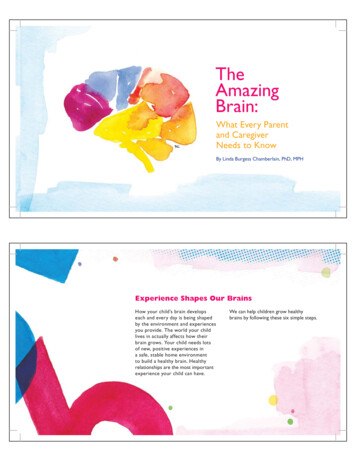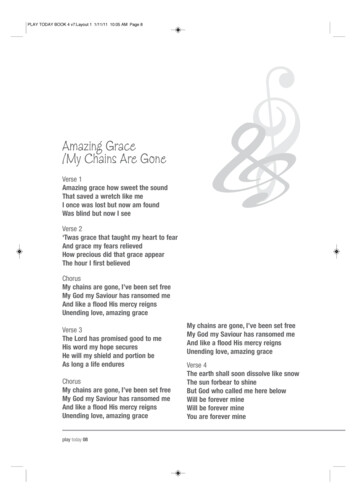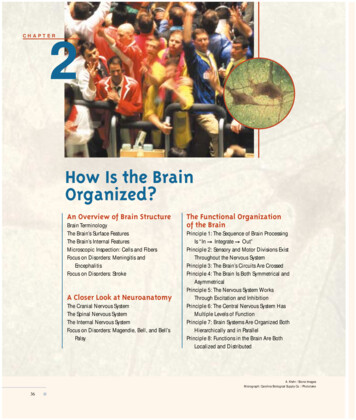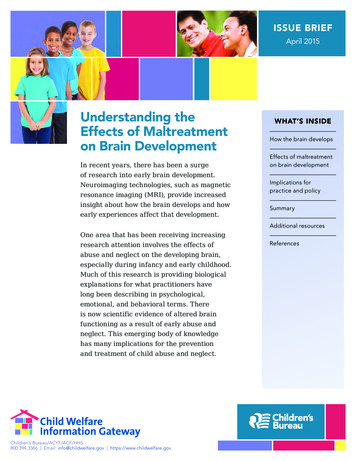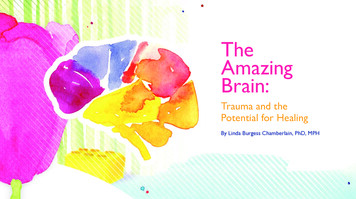
Transcription
TheAmazingBrain:Trauma and thePotential for HealingBy Linda Burgess Chamberlain, PhD, MPH
A baby’s brain is like a flower readyto bloom. From the first momentsof life, a baby’s brain is absorbingnew experiences and being shapedby its environment. Even though aninfant may be too young to haveconscious memories of these earlyexperiences, the developing braindoes not forget.First impressions last a lifetime.A baby’s brain will blossom from lotsof positive, nurturing experienceswith you. Negative experiences havethe opposite effect on early braindevelopment— much like a flowerthat wilts from neglect. Early traumacan leave a lasting imprint on thedeveloping brain. The younger achild is, the more vulnerable theirbrain is to the effects of trauma.Childhood trauma can be any negativeexperience that causes major stressfor an infant or child. Family violence isespecially traumatic for children becausesomeone they are close to is being hurtor hurting them. The trauma of living ina home with domestic violence where aparent is being hurt or threatened can beas harmful as being physically or sexuallyabused. Children exposed to domesticviolence live in fear and chaos—life is likea roller coaster of not knowing what toexpect next. This leads to problems as achild’s brain adapts to survive.You can help children who experiencetrauma by understanding six basic factsabout trauma and brain development.
Surviving or Thriving?The building blocks of the brain develop from the bottom tothe top. When children feel safe and nurtured, they spendmore time in the upper building blocks of the brain where theydo their most important learning such as bonding with you,learning to talk, and getting along with others. When childrenfeel unsafe or threatened, they spend more time in the lowerbuilding blocks of the brain—focusing on survival. This can leadto changes in the brain including:Less development of the upper brainSmaller brain sizeFewer brain connectionsTrauma Interferes with LearningThe lower building blocks of the brain, which are connectingand developing first, are extremely sensitive to trauma.The developing brain can become over-sensitized tostress. Children experiencing early trauma are often easilyoverwhelmed by minor stressors such as a change in theirschedule or routine. They have difficulty soothing or calmingthemselves. The following problem behaviors are commonamong children who experience trauma:Difficulty with focusing and paying attentionAnxious, unable to settle downBullying and other aggressive behaviorsWhen children feel calm and safe, they focus their energyon learning. Children who are dealing with trauma are oftenin a chronic state of crisis. They focus on trying to feel“OK” or normal. This compromises their ability to learn.Traumatized children have more speech problems anddifficulty learning how to read.
PTSD Hurts the BrainWhen posttraumatic stress disorder(PTSD) occurs, the brain gets stuckin the trauma and relives it over andover again. Reminders of the traumacan trigger a flood of stress hormonesbefore a child even knows what ishappening. Reminders of the traumamight be a sound or a smell such aswhat a child ate for dinner the night that“mommy and daddy got really mad.”High levels of stress hormones interferewith brain development and learning.Symptoms of childhood PTSD include:Zoning out, withdrawingSleep problems such as night terrors orrepeated night wakingsLoss of developmental skills such as achild who is learning to speak suddenlystops talkingViolent play such as acting out threatsand physical attacks with toys over andover againBy recognizing the symptomsof PTSD, we can help childrento get treatment as soon aspossible. Therapists who haveexperience working with childhoodPTSD have a variety of techniques towork with young children.Trauma Leads to Other Health ProblemsChildren who experience trauma are more likely to have health problems such asbedwetting, stomach problems, and chronic headaches. Trauma also takes a toll onchildren’s emotional health. Depression, anxiety disorders, and behavioral problemsare very common among traumatized children. These children often start usingalcohol and drugs at an early age as a way to cope or numb their feelings.
You Can Make a DifferenceHealthy relationships with a caring adultcan protect children from the effectsof trauma. Opportunities for childrento talk about what happened or playout their feelings about the trauma canstart the healing process. Allow a childto tell their story without pressuringthem to talk. You should be prepared tohear things that may upset you---adultsoften do not realize how children absorbwhat’s happening around them and howmuch it affects them.Children need to hear that it’snot their fault. Children blamethemselves when bad things happen,so they need lots of reassurance fromyou. Acknowledge their feelings withstatements such as “that sounds like itwas really scary for you” or “it soundslike you were very worried when thepolice came.”Other ways you can help include:Ask a child what he or she is most worried aboutHelp a child to find ways to express their feelingssuch as drawing or journalingProvide lots of structure for daily activities suchas meals, homework, and bedtime so a childknows what to expect and prepare them for anychanges in their daily routinesHelp other caregivers to understand how traumacan affect a child and how to respond supportivelyReduce exposure to violent media such astelevision, video-games, and movies
It’s Never Too LateWe can rewire and grow our brainsover our entire lifetime. Every day, weare learning more about the brain’samazing ability to heal. The way welive and the quality of relationshipswe have can either help or hinder thepotential of our brains to grow andheal. Depression, high levels of stress,and substance abuse can reduce thebrain’s ability to recover. However,physical activity, developing new skills,healthy relationships, and being sociallyactive help our brains to form newconnections. It’s never too late to gethelp and start healing.BrainConnection.comThis Web site provides information about how the brain works and howpeople learn. Many discoveries are being made in areas that relate to thehuman brain, including language, memory, behavior, and aging, as well asillness and injury. BrainConnection.com also provides practitioner-friendlytools for teaching and learning.www.Brainconnection.comChild Trauma AcademyThe Child Trauma Academy, a not-for-profit organization based in Houston,Texas, is a collaborative of individuals and organizations working to improvethe lives of high-risk children through direct service, research and education.www.childtrauma.orgThe National Child Traumatic Stress NetworkThe NCTSN was established to improve access to care, treatment, and servicesfor traumatized children and adolescents exposed to traumatic events.www.nctsnet.orgChildren’s Crisis Treatment CenterCcTC provides a full array of high-quality, comprehensive mentalhealth services to children and their families in Philadelphia, includingtrauma-focused therapy to children 18 months through 13 years.www.CcTCkids.orgZero-to-ThreeThis site offers a comprehensive interactive resource for parents and earlychildhood education professionals on healthy development of children ageszero to three.www.zerotothree.orgDr. Baldwin’s Trauma Information PagesThese Trauma Pages focus primarily on emotional trauma and traumaticstress, including PTSD (Post-traumatic Stress Disorder) and dissociation,whether following individual traumatic experience(s) or a largescale disaster. The purpose of this award winning site is to provideinformation for clinicians and researchers in the traumatic-stress field.www.trauma-pages.com/bookstore.php
The Amazing Brain: Trauma and the Potential for Healing, 2008, Philadelphia, PA. This brochure waswritten by Linda Burgess Chamberlain, PhD, MPH with support from the Institute for Safe Families and MultiplyingConnections of the Health Federation of Philadelphia and Advocates for Youth.Linda Burgess Chamberlain is the founding director of the Alaska Family Violence Prevention Project. Anepidemiologist specializing in domestic violence, she is an internationally recognized speaker on the effects of violenceon children and brain development. She lives on a rural homestead outside of Homer, Alaska with her dog team. Anational Kellogg Leadership Fellow, Dr. Chamberlain is also a motivational speaker and uses “lessons from the trail”to promote key strategies for teamwork and leadership.howlinghusky@gci.netThe Institute for Safe Families (ISF) is a non-profit organization whose mission is to prevent familyviolence and promote the health and well being of each member of the family and their community. Since theearly 1990’s, ISF has developed innovative programming and built coalitions that unite health care providers withsocial service, policy experts, researchers, academicians, and victim/survivors. One of ISF’s unique strengths hasbeen to create forums for cross-systems dialogue aimed at building greater capacity for more effective preventionand response to family ngConnectionsMultiplying Connections of The Health Federation of Philadelphia is a cross system collaborative whosemission is to translate the research on early childhood brain development into better practice throughprofessional training and organizational and policy change. Multiplying Connections is developing materialsand strategies to promote trauma informed and developmentally appropriate care across the public child andfamily service system in the City of Philadelphia. This capacity building initiative is funded by the William ates for Youth is dedicated to creating programs and advocating for policies that helpyoung people make informed and responsible decisions about their reproductive and sexual health.Advocates provides information, training, and strategic assistance to youth-serving organizations,policy makers, youth activists, and the media in the United States and the developing world.www.advocatesforyouth.orgDesign and Illustration: Peter CamburnAbout Face Design, www.aboutfacedesign.net
the opposite effect on early brain development— much like a flower that wilts from neglect. Early trauma can leave a lasting imprint on the developing brain. The younger a child is, the more vulnerable their brain is to the effects of trauma. A baby’s brain






